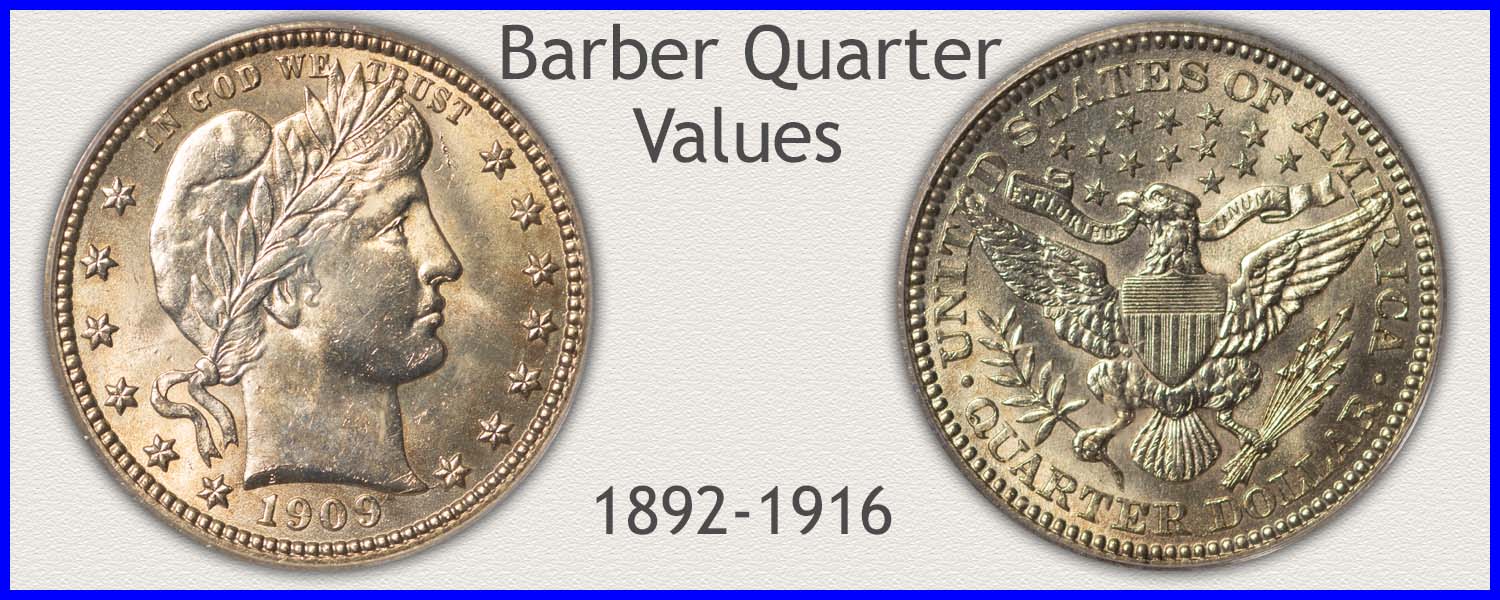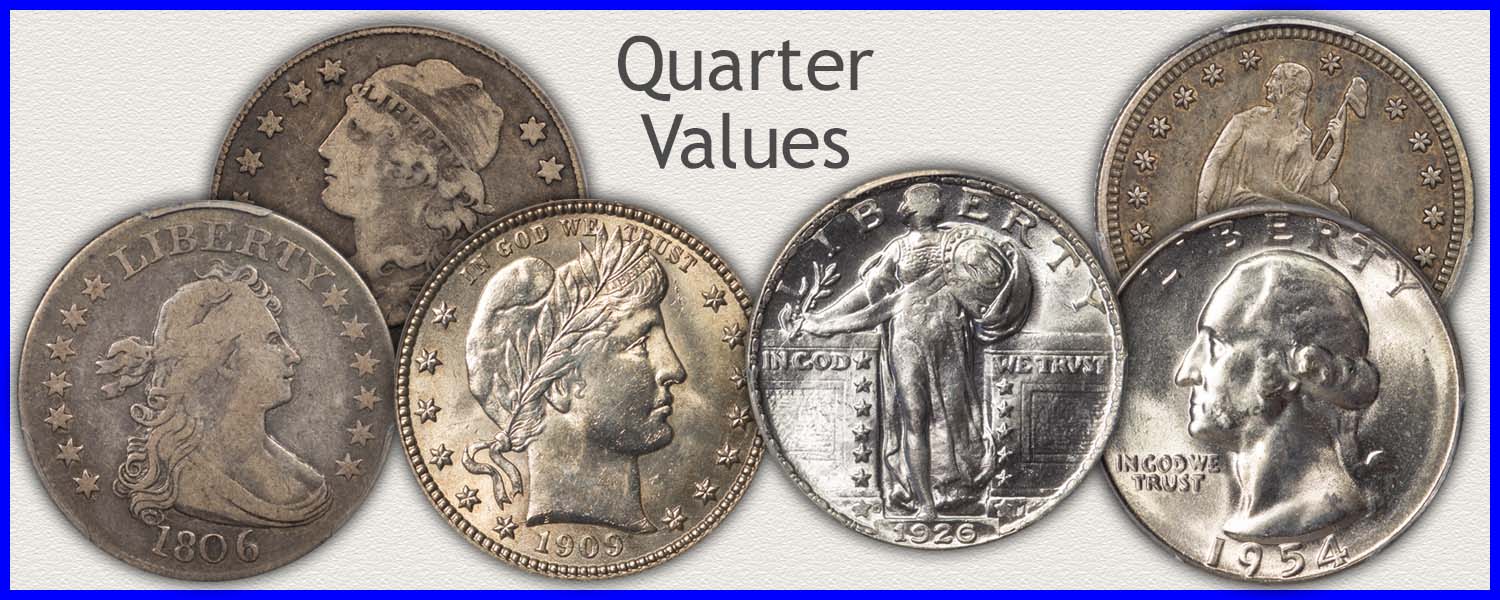Coin Values Moving with Precious Metals: Up-Dated 12/22/2025: Gold $4413 | Silver $68.92
1910 Quarter Value
1910 quarter value starts at $16.64 and represents an example that has been heavily worn.
The aim of coin collecting is to obtain coins in excellent condition when assembling sets. With this demand for quality, quarters in above average condition are worth a premium. To recognize these high-quality coins, a step-by-step method to judge condition is used.
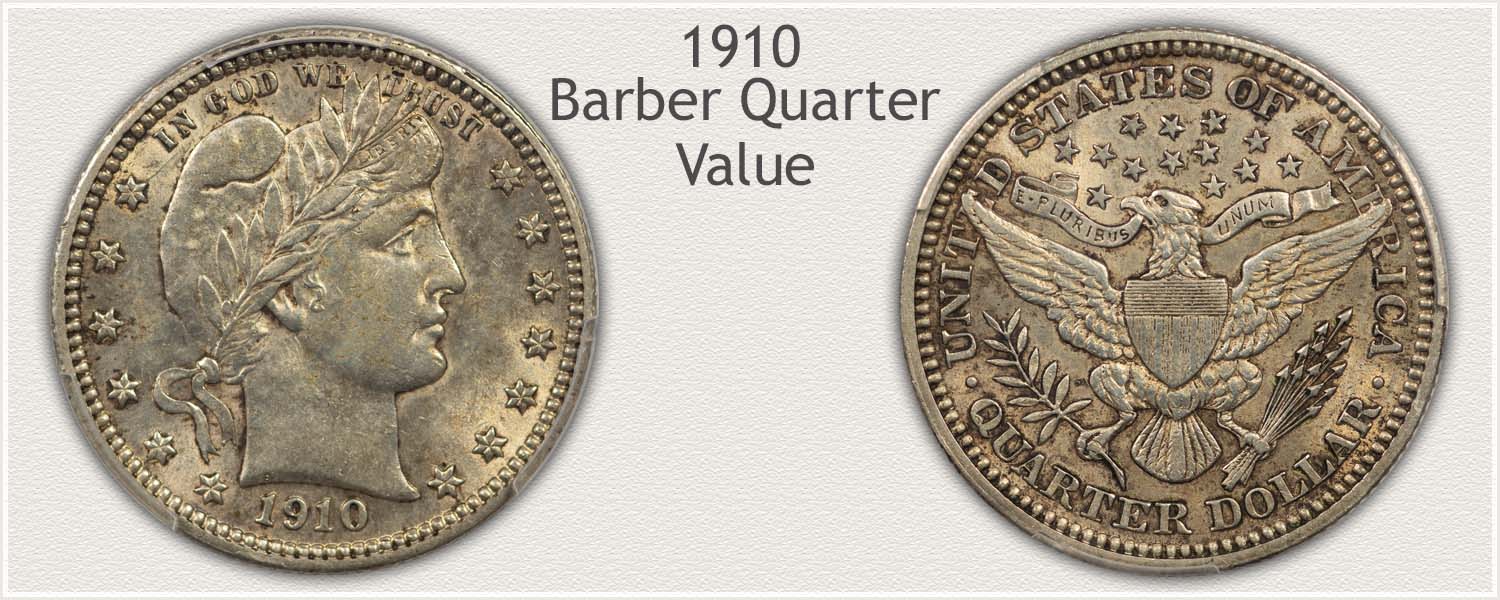
Steps Leading to Value:
- Step 1: Date and Mintmark Variety - In order to describe these old quarters accurately, both the date and the mint variety are identified. There were two different mints that produced these 1910 quarters.
- Step 2: Grading Condition - The condition of many of these quarters that have survived to the present day is low quality. Finding essential features of the design clearly visible indicates the coin is above average.
- Step 3: Special Qualities - Subtle points frequently contribute to the rise of values. To complete the value process, additional points and features are identified. Storing coins properly is an important consideration.
| 1910 Quarter Value | ||||
|---|---|---|---|---|
| Condition of Coin | ||||
| Date | Good | Fine | Extremely Fine | Mint State |
| Barber Quarter Values Updated | 12/22/2025 | |||
| 1910 | $16.64 | $19 | $85 | $180 |
| 1910 D | $16.64 | $37 | $218 | $308 |
Listed is a range a collector would sell Barber quarters to a dealer. Use as a guide.
Step 1: | Confirm Date and Mint Combination
Two Date and Mint Combinations of 1910 Quarters
The mint in Philadelphia was the primary source for 1910 quarters. Additionally, the branch mint in Denver contributed coinage to the series as well, but at far fewer numbers.
Collectors place importance on completing collections to include all date and mint issues. It is necessary to identify these different varieties. Reference the images below highlighting mintmarks used to identify the different mints.
1910-D Barber Quarter
"D" Mintmark on Reverse: Denver Mint Struck the Coin
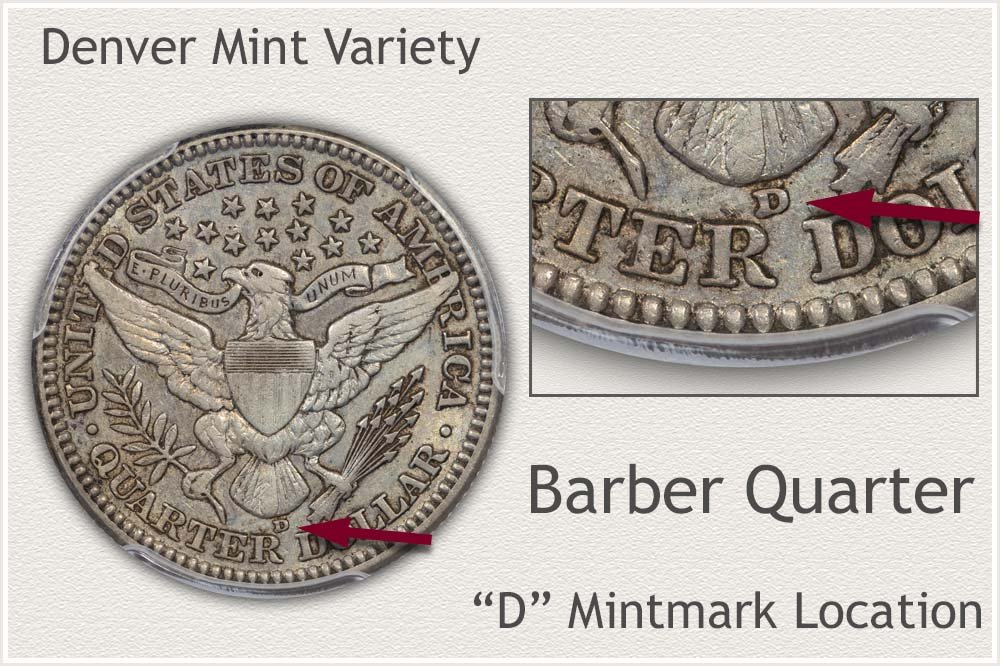
1910 quarters minted at the Denver mint are the scarce variety of the year. Production of quarters was limited to just two mints, with Denver striking a below average 1.5 million for the year. Notice the quick jump in value for examples in better than heavily worn condition. Although many are still available today, a majority are in less than collectible grades.
These old quarters are collected by date/mint combinations, requiring the identity of mint issue. Looking on the reverse above the "R" and "D" of Quarter Dollar, the prominent "D" is the mintmark of the Denver mint.
1910 Barber Quarter
No Mintmark on Reverse: Philadelphia Mint Struck the Coin
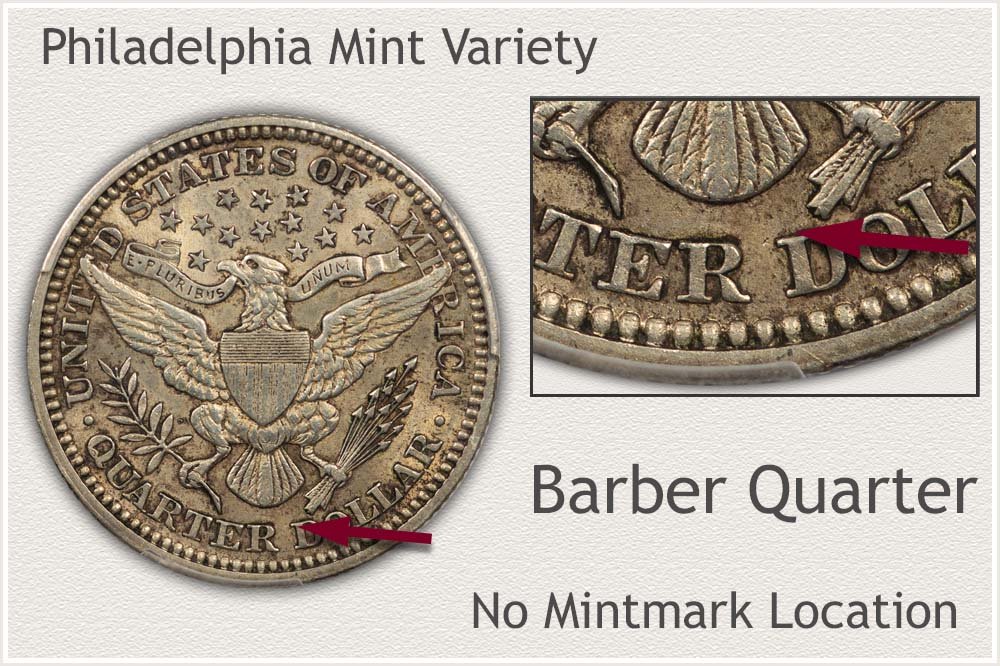
The Philadelphia mint was the only mint to produce Barber quarters every year of the series, out of the four mints involved. 1910 represents a historically low mintage of the series, with 2.2 million produced. A nice coin is attractive to new and beginning collectors. With added demand from silver investors, this is a significant year and variety in the series.
Although finer grade pieces are noticeably harder to locate, heavily used examples are still readily available. Strong premiums are given as a result of the rarity of the better, collector quality coins, as noted on the chart.
Absence of a mintmark is the important indicator to identifying Philadelphia mint coins. Philadelphia did not place a mintmark on coins during the Barber series. The space above the letter's "R" and "D" in "Quarter Dollar" on the reverse is empty.
Step 2: | Grades Define Condition in the Coin Collecting Hobby
An Individual 1910 Quarter Value is Identified by Condition
A detailed examination of condition is necessary because premiums in collector quality are high. The condition of these coins is evaluated by grading key features, which classifies them into value categories.
Viewing examples from various grades, it becomes easier to see the significant and small changes to the surface that occur as a coin develops wear. Identify the areas highlighted in the descriptions that indicate stages of wear on specific parts of the design.
Mint State Grade
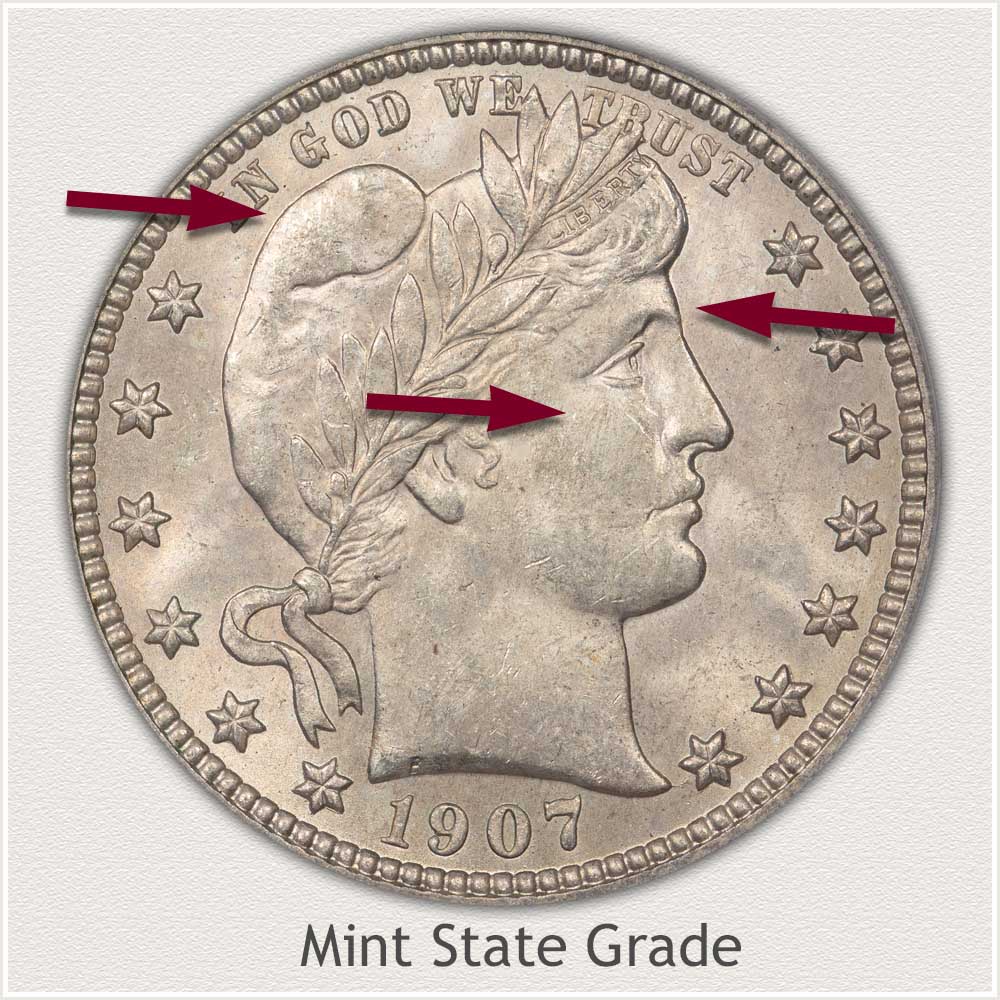
Mint State: The highest possible rating for a coin's condition is known as the Mint State grade. This collector term refers to a coin that has not been subjected to any amount of wear. Both the high relief areas and low areas of the surface display complete luster and shine.
Fine and major details are featured in both high and low areas of a coin's design. Inspection of Liberty's eyebrow, a very high relief point, reveals no flattened metal or wear, and its contour remains rounded. Just a light amount of wear causes a flattened area on the eyebrow.
Additionally, luster is a delicate, fine texture that reflects light, causing a minted surface to sparkle and shine. Under a light, intact luster radiates across Liberty's cheek and under her eye while tilting the coin's surface. Being an exposed and high area, her cheek loses its luster quickly when worn, becoming a smooth texture. Full luster over the cheek and neck of a Mint State Barber quarter makes it easy to identify.
Extremely Fine Grade
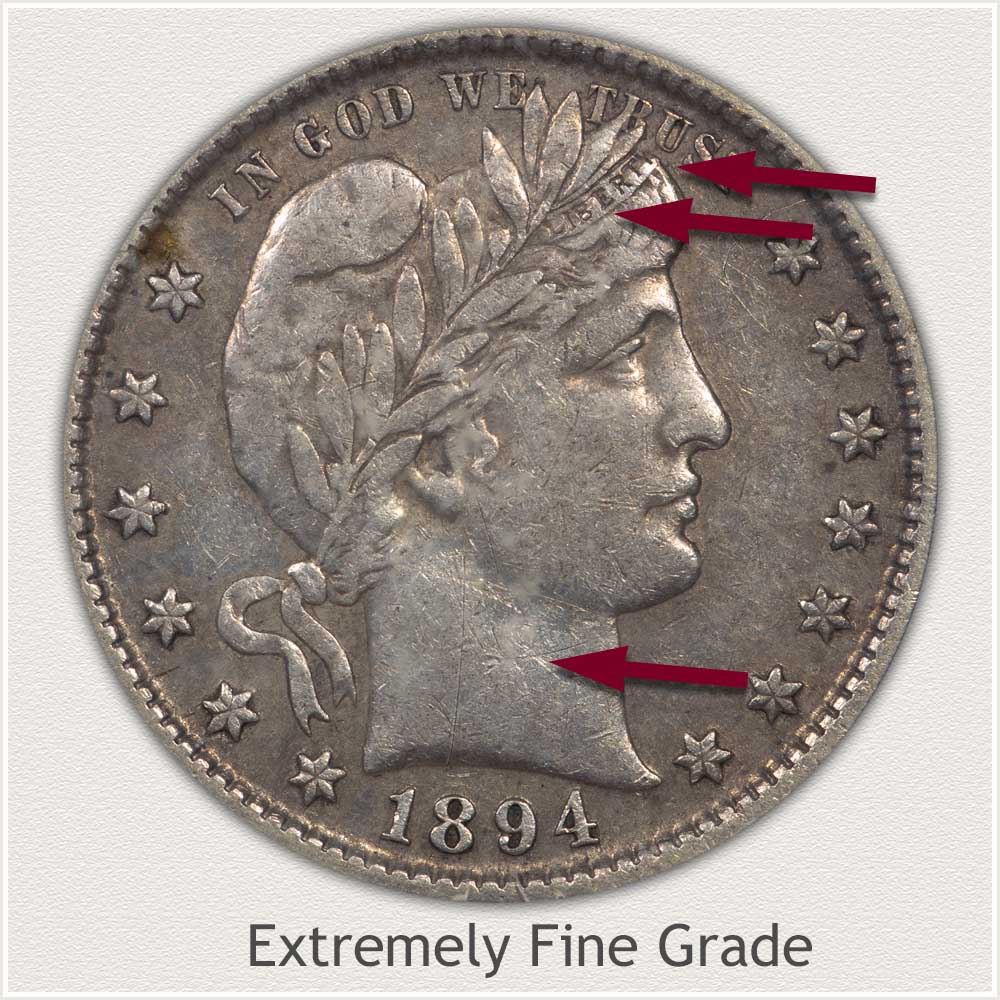
Extremely Fine: Barber quarters are now considered an old and obsolete series. Scarce examples are those with just minor wear. Extremely Fine grade is used to describe coins in a condition showing wear restricted to only high points of the design.
Those parts of the design most vulnerable to early wear are used as indicators for measuring wear and detail loss. First, the headband that Liberty wears in her hair is a very high-profile area. This area shows the first signs of wear, and the condition of the lettering and band is used to determine the extent of metal loss. A full and bold "LIBERTY" across the band places the example strongly within its grade. The lower edge of the band is still largely distinct, and all letters are complete.
Additionally, Liberty's face and neck are only slightly smoothed, with high and low contours remaining. Overall, the coin's design is well-detailed, with the majority of the fine lines visible in the hair near the ribbon, its knot, and wreath's leaves. Handle these high-quality coins by their edges to preserve their condition.
Fine Grade
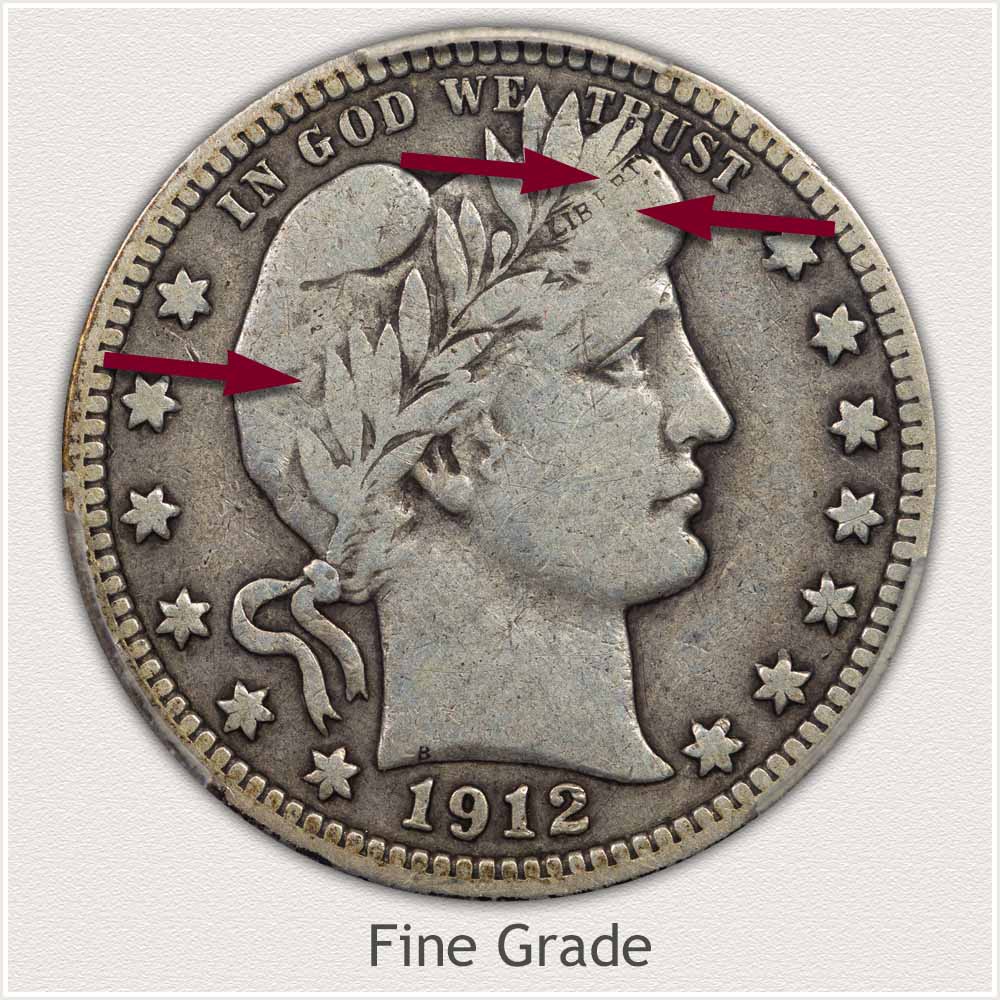
Fine Grade: A dedicated collector base is a key factor in supporting high values for these quarters. Condition of a quarter in Fine grade is characterized by moderately worn surfaces with numerous details remaining. These appealing coins, having a nice amount of detail, are assembled into worthy collections of this vintage series.
The headband bearing the letters "LIBERTY" is one of the areas to inspect when verifying a high-quality example. Each letter is deeply impressed into the design, when all are visible, a coin is considered in the Fine grade of condition. If any of the upper or lower edges of the ribbon are still present, the coin is considered solid for the grade.
Overall, most original, small details are visibly worn, with many reduced to a smooth surface. The wreath's leaves above her ear are now flattened and become a smooth, flat design, losing their high and low contours. It is important to note that all leaves in the upper row are outlined with just traces of blending. In the lower row, the leaf edges are clearly blended.
A coin with moderate wear and no distracting large marks or dents is an excellent example of collector quality.
Good Grade
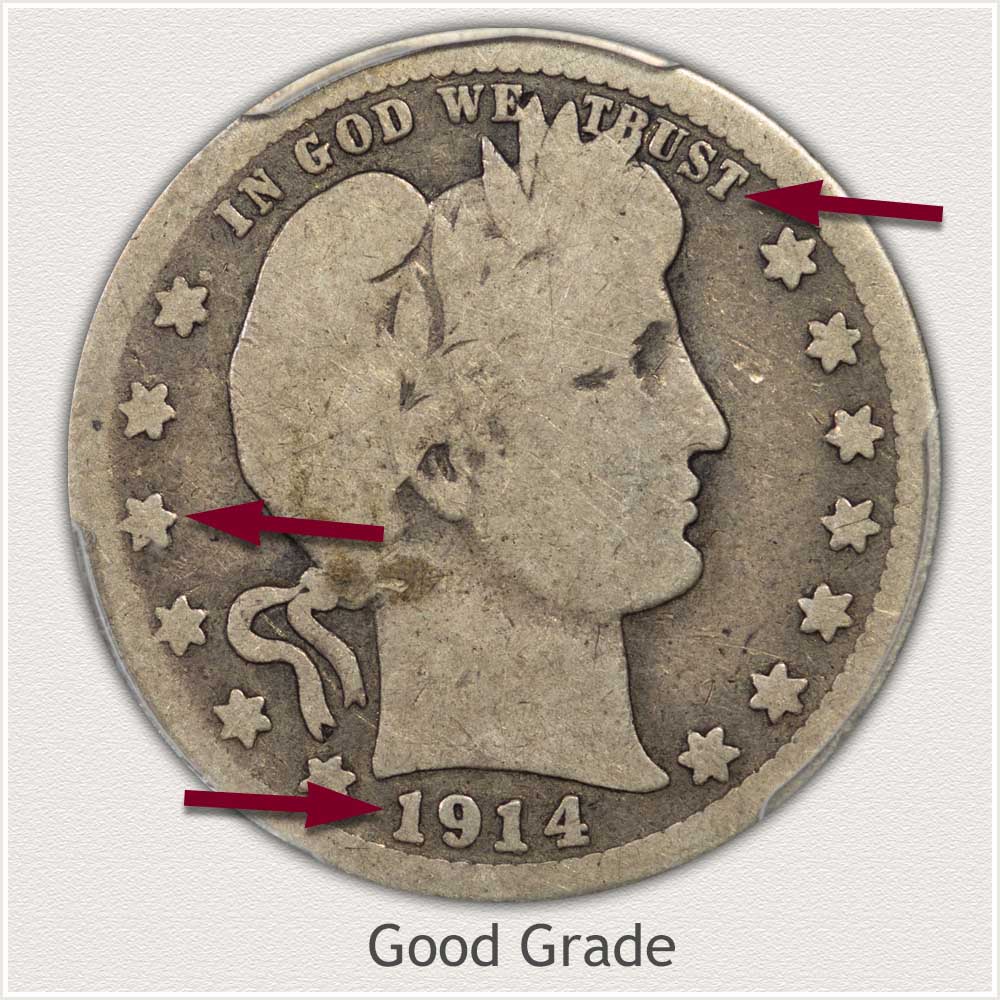
Good Grade: A quarter is in good condition if all of the key design elements are smooth but still well raised above the fields.
Starting with the date, every numeral is crisp and clear. No joining with the rim is causing them to look faded. The rim itself has been worn down to a small fraction of its original height above the field due to years of use. A closer inspection of the inner edge reveals that it remains intact around the entire coin.
Each of the stars in the design is complete and fully outlined. The lettering of the motto and these stars are still clearly raised, giving the entire coin a clear appearance. This example has avoided receiving any large marks and is a quarter in worn but appealing condition.
How to Video: Grading Barber Quarters
Follow the video and images while grading to concentrate on specific areas. Inspecting these vintage quarters, key elements are used to determine their quality and extent of wear.
Video, Images and Descriptions | Grading Barber Quarters
Step 3: | Special Qualities | Maintain Value and Originality
Safe Storage to Protect Barber Quarter Value
Barber quarters have been around for a long time; lasted minted in 1916. Over these many years, the place where they are stored, housed, or presented as a collection impacts their surface preservation. Some fair well and are housed in a protected manner, others often suffer damage.
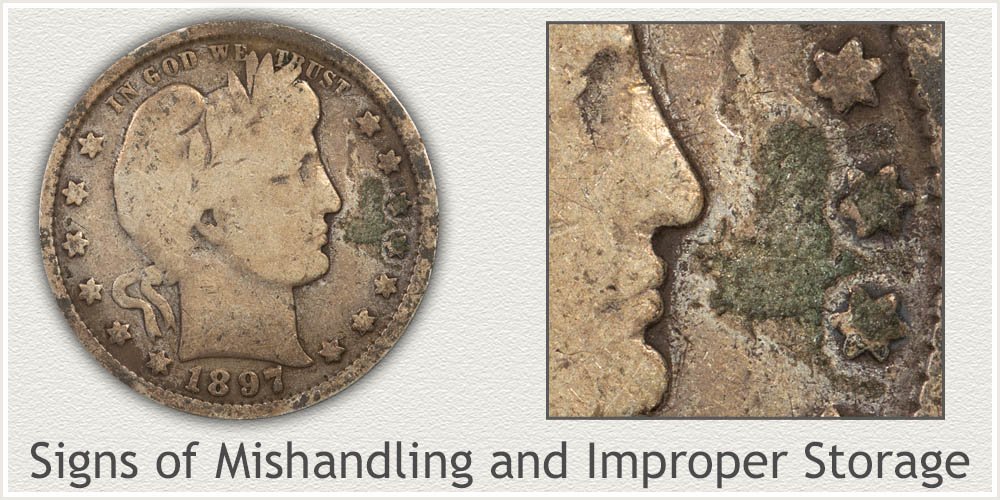
The quarter imaged above lacked proper housing at one time in its past. Just in front of Liberty is a large area of discoloration. When examined closely, the darkened area is just slightly raised, indicating not only an unnatural color but also corrosion is taking place. Tops of the stars and portions of the rim are all showing deterioration of the natural surface.
One main consideration when maintaining coins is humidity of the air. Dampness on silver darkens toning, often to deep gray-black. Humidity reacting with copper in the alloy of quarters causes a slight green tint called verdigris, a form of corrosion. Removal of the corrosion spot often shows pitting of the metal below.
Any old coin with discoloration and especially signs of corrosion is considered damaged. The damaged displayed is reducing appeal and value of an otherwise in-demand collectible.
Examine closely all surface areas of these quarters as part of grading their condition. Examples with nice original, undamaged surfaces are high quality and sought by dealers and collectors.
References
U.S. Mint. 1911 U.S. Mint Annual Report
https://nnp.wustl.edu/library/book/323
U.S. Mint. Catalogue of Coins of the United States.
https://nnp.wustl.edu/library/book/554591
Coin Values | CoinStudy Articles
Date by Date
In Depth Barber Quarter Values
1892 to 1916
Barber Quarter Value | Many Scarce Dates
1910 is just one of twenty-five dates to the Barber quarter design series. Each is valued separately on the full value chart. Steps identifying date, mint, and condition lead to finding an accurate place on the chart.
Quarter Values | Scarce Series and Designs
Many appealing designs are part of the quarter denomination of U.S. coinage. Barber quarters were minted long after the first quarter in 1796. Bust and Seated quarters are the very early issues and highly valued. Identify your old quarter with images and links to the series.
Old Coin Value | Identify Your Coin
Of the many U.S. coin designs, match your coin to images to identify its correct series. Links lead to specific value charts and steps to follow in determining how much old quarters are worth.
Print the Coin Values Worksheet
List valuable Barber quarters individually with important date, mint, and condition descriptions. Continue with the rest of your collection. Record current values, organizing your coin holdings.
Safe Coin Storage | Recommendations
Worn coins show wear, nicks, and marks from use. Mint state coins are at risk of discoloration and darkening over time. Proper storage helps protect, maintain, and preserve its value. Collectors use individual and bulk storage options to house their collections and groups of coins.
The U.S. quarter denomination was introduced in 1796. Many dates of the early years are very rare and most are scarce and highly valued. Beginning with the Seated Liberty series, collectors find difficulty completing sets because of the rarity of many date and mint examples. Barber quarters are represented, Standing Liberty and Washington series all have coins with potential.
Selling Coins | A Defined Process
Following a process to accurately identify your coins and current market value is a strong start to receiving a fair offer. Each series is different in key elements to recognize. Judge and evaluate your coins and then reference the dealer listings.
★Coin Values Discovery finds 1910 Quarter Value and...
All old coin values. Images are used to follow a step-by-step method when determining how much U.S. coinage is worth.
